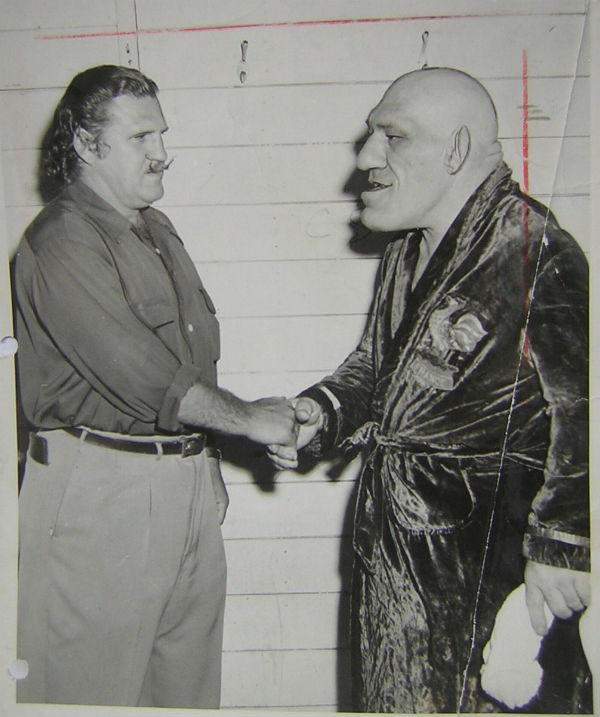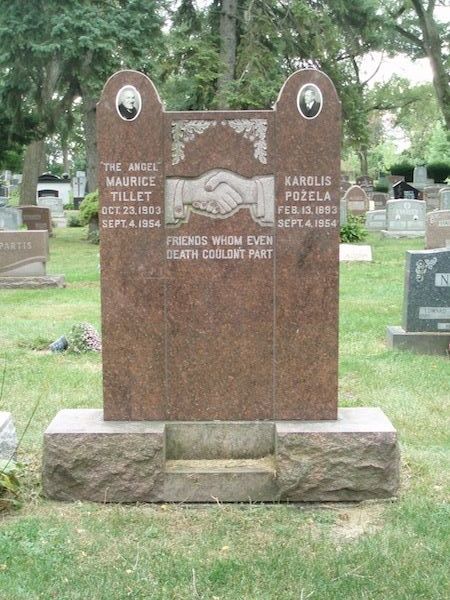I BOOED THE HELL OUT OF HIM MANY TIMES
by
Jan Dellinger (2015)
Repeated experiences often bring one to certain conclusions. For example, after taking all manner of people around the York Barbell Museum/Hall of Fame over the years, I firmly believe that there is at least one exhibit therein which anyone, even if not interested in the Iron Game remotely, can relate to one some level.
One event which helped bring me to this unshakeable contention was the day that a busload of Senior Citizens from Massachusetts arrived unexpectedly and were suddenly inside and all over the museum. Actually, I came to a couple of conclusions that day: the first was that there really wasn't that much difference between a group of 10-year-olds in a museum and a group of 75-year-olds in terms of noise and hubbub. The only constant was that the younger group could move around a bit faster, but the attention span was about equal.
On the upside, the Elderly Invasion gave me the opportunity to converse firsthand with two very colorful female live wires who actually saw Maurice "The French Angel" Tillet wrestle. When I approached them they were eyeballing the death mask of The Angel, reminiscing on all cylinders about being ringside numerous times at the Boston Gardens when Tillet headlined.
So, they saw him up close and still possessed vivid recollections of his bizarre countenance and general "other worldly appearance." Or as John Grimek, who associated with Tillet and his manager Karl Pojello a time or two, summed it up, "If you were three sheets in the wind and staggering down a dark street or alley, and the Angel came up on you, you would have sobered up immediately!"
Back in the day (1940s) when our "Boston Broads" thought a hot night out was burgers and taking in the matches at the Boston Garden, Tillet was the arch villain and top box office attraction of the mat world. Hence, as one of them relayed to me, "I booed the hell out of him many times at the Garden. He was beyond ugly and his foul tactics whipped the crowd into a real frenzy!"
Right off the bat, let's recognize that while I initially attempted to offer what little I knew about the French Angel (which I received primarily from Grimek), I, instead, got the education . . . and got it with gusto! Secondly, of all the various exhibits in the York Museum, Tillet's death mask consistently elicits spellbinding curiosity among those passing thru. And why wouldn't it? It is a rare sight to see up close a "melon" that (over)size and contemplate it being atop a human body. Why, the actual size of Tillet's ear is at least as big as the average man's fist. And the size of his nose isn't far behind.
"Wild Bill Zim" (Wactau Zmitrovitz) with Maurice Tillet
And then when you tell onlookers that his head was on top of a 5-7, 270-pound body, you get more reactions. Once I had a person declare this plaster cast had to be a con. Then I showed him wrestling mag covers featuring Tillet from the 1940s. That shut him up!
Bookfinder:
Tillet suffered from acromegaly, an abnormality of the pituitary glands, which typically causes one to grow to enormous height and physical size (think Andre the Giant), along with vastly enlarged bone formations and features of the feet, head and hands. Tillet, who was also referred to as the Giant Dwarf by wrestling PR people (talk about oxymoronic contrasting), never got the extreme height, topping at 5-7 or 5-8. Moreover, the bulk of that 270-275 pounds he sported resided in his upper body, which was mounted on comparatively short and bowed legs.
Regarding Maurice's background and how he ended up in professional wrestling, he was born in 1903 in the Ural Mountains of Russia to French parents. His railroad engineering father was killed while he was rather young, and the outbreak of the Bolshevik Revolution in 1917 prompted his mother to take him and flee to Reims, France.
Prior to the age of 17, he exhibited no signs of acromegaly, and was receiving the necessary education to pursue a law degree. Then, the outlandish physical growth and distorted features began to appear. Believing that any hope of a law career was gone thanks to his appearance, he enlisted in the French Navy, perhaps in hope of finding a medical remedy.
Hewitt further contends that one Paris evening in 193, while strolling along the sidewalk cafes, a touring master catch wrestler and combat artist, Karl Pojello, saw the huddled mass of despondent humanity (Tillet), barely able to amble along. "Pojello, well known as a Good Samaritan, immediately wanted to help the poor creature. The veteran wrestler began addressing him in various languages until he responded to Russian."
In contrast, Wikipedia states that Tillet and Pojello met in Singapore in 1937, with no explanation of how the former got there. Here again, we may have the create-an-illusion penchant of pro wrestling to thank for the contrasting stories as the early PR build-up of Tillet on the mt circuit specified that Pojello "found" his protégé while tiger hunting in Singapore.
Subscribe to whichever story you like, but Pojello recognized box office gold when he saw it, and he and the French Angel, as he quickly became known, began teaming up in 1937. The Angel embarked on his celebrated mat career in France and England the following year (1938), experiencing much success over the next two years.
Maurice Tillet and Karl Pojello
As an aside, the sole British wrestler who apparently wouldn't "go over" for Tillet, and whose name is familiar somewhat with iron folks of a certain age, was Bert Assirati. Aside from his well-documented strength, endurance and overall athleticism, Bert was a product of the ultra-tough Wigan Snake Pit in England where the stiffest forms of submission style Catch wrestling were taught. Very probably, Assirati did not feel particularly inclined to cooperate with other wrestlers who he didn't think were in his class on the mat. And especially, if they were receiving promotional opportunities that he thought he should be receiving but wasn't.
Having said that, Tillet, over the course of his roughly 15-year mat career, met many, many of the great names of the mat world on both sides of the Atlantic.
After having a spectacular mat run as an undefeatable monster in Europe, and with WWII about to besiege Europe, Pojello and the Angel left for the United States, specifically, Paul Bowser's well established Boston promotion, debuting in January of 1940. Whether this is the notorious wrestling style of PR previously mentioned or just the facts, it was reported that women were said to have fainted at his first sighting. We do know of at least one who admits to booing him vociferously at every opportunity.
Right from the jump, the Angel was making serious moolah for Bowser's promotion, and every other wrestling promoter in the country wanted Tillet in his territory. Of course, such clamoring made Bowser still more money. Unquestionably, the record shows that The French Angel was the number one box office draw of the 1940s. Keep in mind that for the first half of that decade, huge numbers of Americans were overseas fighting a war.
Click Pics to ENLARGE:
Also significant is the fact that being the "face" of pro wrestling literally during the '40s, his dominance at the box office renders him sort of a historical bridge, and hence has terrific relevance to the evolution of pro wrestling, getting the activity "over the hump" of transitioning from newspaper/magazine coverage solely to the era of television.
By the way, who was the dominant box office wrestling attraction in the early TV era: The Anti-Angel . . . Gorgeous George!
Promo of Gorgeous George with Maurice Tillet
Another historical wrestling point which centers on Maurice Tillet's ring character: It possessed such name recognition and drawing power that promoters kept trying to catch lightning in a bottle by unveiling a number of other Angels -- Swedish, Super Swedish, Irish, Russian, Polish and Lady. None, however, matched Tillet's original for generating magic at the gate.
So how did the Tillet saga end? As is often the case with acromegaly sufferers, not as pretty as one might hope. Insiders contend that the first signs of the disease interfering with his ring capabilities began sometime in 1945, although they were not sufficient to force him into retirement for another eight years.
His final match came, ironically, in Singapore, and against, you guessed it, Bert Assirati. Retirement or not, old Bert didn't let up on him on this occasion either.
Tillet passed away from the ravages of heart disease on September 4th, 1954 and is buried in the Lithuanian National Cemetery located in Justice (Cook County), Illinois.
Maurice Tillet/Karl Pojello gravestone
As to the various death masks of busts of Tillet residing in various venues, in 1950 Chicago sculptor Louis Linck made a series of plaster busts commemorating the life and career of The Angel, with one of his products displayed in the Chicago International Museum of Surgical Science.
Reportedly, Tillet allowed three separate death masks to be done just prior to his passing. Again, reportedly the process was performed by fellow grappler Bobby Managoff, who was reputed to have generous artistic skills and connections in that world. The "copy" residing in the York Barbell Museum was first given to Milo Steinborn, who in turn donated it to York.
Another copy of the Tillet death mask was donated to the Warren Anatomical Museum at Harvard by industrialist Patrick "Leonard" Kelly, who was a close personal friend of Tillet's. Few fans ever comprehend that Tillet was educated, quite intelligent, religious, and well-traveled with many outside interests.
Kelly also donated another death mask copy to the National Wrestling Hall of Fame -- Dan Gable Museum in Waterloo, IA.
According to certain internet sources, there was also a bronze death mask copy, which had been in the possession of mat promoter Paul Boesch. Seeming verification of its existence came via published pictures in a 1980s Japanese wrestling magazine depicting the inside of Boesch's Houston offices. Shown is a bronze Angel death mask/head . . . along with bronzed fists reportedly belonging to Primo Carnera on each side.
To my knowledge, to date the current whereabouts of the head once on Boesch's possession has not been ascertained. And as if to annoy us even more, there are implications by French Angel historians on the internet that a fifth mask might exist out there somewhere.












No comments:
Post a Comment